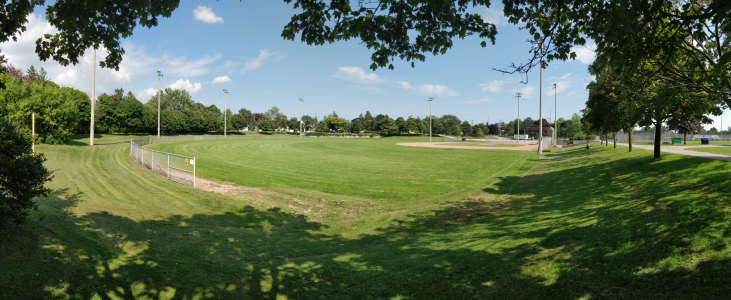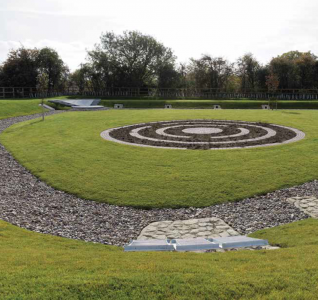Dry ponds
Also known as infiltration basins. Dry ponds are a grassed alternative to bioretention cells. This permits the landscape to be accessed and used as an amenity space.
Overview[edit]
Dry ponds are recommended as flood control structures to accommodate occasional excess overflow downstream of other structural BMPs. They should be integrated into the landscape as useful, accessible public space.
Dry ponds are ideal for:
- Managing infrequent extreme flow events,
- incorporating into parks and other green recreational spaces,
- distributing across a larger development site
Design[edit]
Sizing[edit]
The surface storage volume of a dry pond (Ap) is determined:
Where:
- RVCT = Runoff volume control target (mm)
- Ac = Area of the catchment (m2)
- f' = design infiltration rate (mm/hr)
- t = time permitted for ponding to infiltrate (hrs) (typically 48 hours)
Excess flow control[edit]
Modeling[edit]
| Stage Storage | |
|---|---|
| Name | Important to have a unique name, to connect it with the catchment area |
| Storage type | Dry detention ponds |
| Bottom elevation (m) | This is important to correspond with other components, e.g. when the overflow is coupled to another BMP within a treatment train |
| Maximum depth (m) | |
| Lined/unlined | Unlined (ideally) |
| Underlying soil | Choose from five; sandy soils drain more quickly. |
| Evaporation factor | ? |
| Suction head (mm) | ? |
| Saturated conductivity (mm/hr) | ? |
| Initial soil moisture deficit (fraction) | ? |
| Curves | |
| The Curves table is designed to accommodate the side slopes. The top line begins at 0 m, with subsequent depths in the following lines. | |
Materials[edit]
Resilient turf grasses are particularly useful in the design of vegetated filter strips, dry ponds and enhanced grass swales. The Ministry of Transportation have standardized a number of grass mixes[1]. The 'Salt Tolerant Mix' is of particular value for low impact development applications alongside asphalt roadways and paved walkways.
| Common name | Scientific name | Proportion |
|---|---|---|
| Tall Fescue | Festuca arundinacea | 25 % |
| Fults Alkali Grass | Puccinellia distans | 20 % |
| Creeping Red Fescue | Festuca rubra | 25 % |
| Perennial ryegrass | Lolium perrenne | 20 % |
| Hard Fescue | Festuca trachyphylla | 10 % |
Gallery[edit]
Stormwater lagoon, Wilmhurst Road, Warwick. UK. Photo credit: Robin Stott
Dry polder northwest of Vincencov, Prostějov. Czech Republic. Photo credit: Jiří Komárek
- ↑ Ontario Provincial Standard Specification. (2014). Construction Specification and for Seed and Cover OPSS.PROV 804. Retrieved from http://www.raqsb.mto.gov.on.ca/techpubs/ops.nsf/0/3a785d2f480f9349852580820062910a/$FILE/OPSS.PROV 804 Nov2014.pdf








